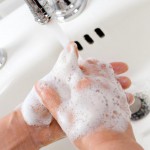Triclosan
[Update 9.2.16: VICTORY! The FDA has ruled a ban on antibacterial soaps containing triclosan, triclocarban and 17 other chemicals, but triclosan is still found in some products like toothpaste, cleaning products and cosmetics. Learn more.]
What Is It and Why Should You Be Concerned?
Triclosan is a synthetic (man-made) antimicrobial chemical designed to kill germs. Yet it doesn’t kill viruses, which are the causes of colds and the flu.
Exposure to triclosan has been associated with some serious health concerns:

- It’s been linked to hormone disruption and increased risk of breast cancer.
- It’s been found in blood and in breast milk, which means that women are passing this chemical on to their developing babies.
- It’s bioaccumulative (it builds up in our bodies) and persistent (it doesn’t break down easily in the environment).
- Widespread use of triclosan has also raised concerns about the creation of superbugs, which are bacteria and viruses that have become resistant to the antimicrobial compounds and antibacterial drugs developed to combat them, leaving us with fewer tools to fight infectious diseases.
Where is Triclosan Found?
Triclosan is commonly added to household products such as:
- Antibacterial hand & dish soaps
- Disinfectant products
- Tartar-control toothpastes
- Some deodorants
- Some fragrances
When it’s washed off skin and down the drain, it also ends up in our lakes, rivers, and other water supplies, where it’s toxic to aquatic life. It even ends up in sludge that’s applied to agricultural lands as a fertilizer, contaminating that soil as well.
The bottom line is that triclosan is unnecessary to use at home. Studies have shown that this toxic chemical is no more effective at preventing illness or removing germs than soap and water.
Easy Ways to Avoid Triclosan
- Reduce your use of disinfectants, which may contain triclosan. For household cleaning, the surfactants in soap help lift the dirt off surfaces, while a little scrubbing and good rinsing will carry away the dirt (and any germs).
- Avoid antibacterial hand soap. Washing with regular soap and water does wonders to get your hands clean without this harsh chemical. Wash your hands regularly for 20 seconds (the time it takes to sing “Happy Birthday” in your head).
- Read labels to avoid other products, like deodorant or toothpaste, that contain triclosan as an active ingredient.
You can use Skin Deep to find personal care products that don’t contain triclosan, and GoodGuide for cleaning products free from triclosan.
Help Get Rid of Triclosan on Our Homes for Good!
Ask companies to stop using triclosan in household products! Call the customer service line on your favorite brands and ask them to remove it. Many companies, like Seventh Generation and CleanWell, make cleaners, hand sanitizers, and soaps that get rid of germs without the use of this harsh chemical.
You can use your consumer power to let companies know that you want them to make safer products! Women make 85% of buying decisions in the average home – that’s a lot of consumer power, and companies WILL listen. Read labels and buy from companies that don’t use triclosan.
More Information & Fun Resources
- Read WVE’s report Disinfectant Overkill
- Check out our Room-by-Room Chart to Reduce Use of Disinfectants
- Watch the Disinfectants Horror Show



